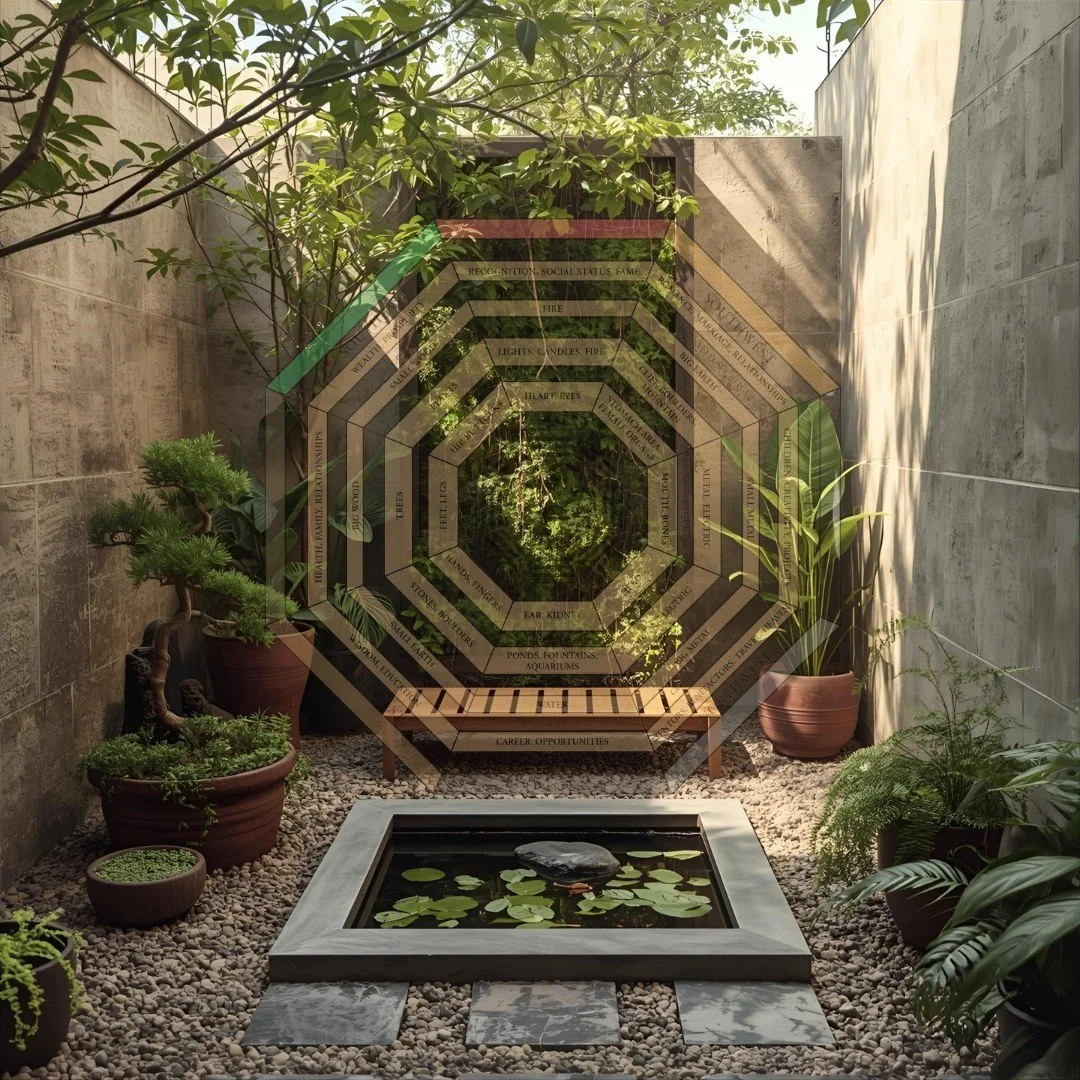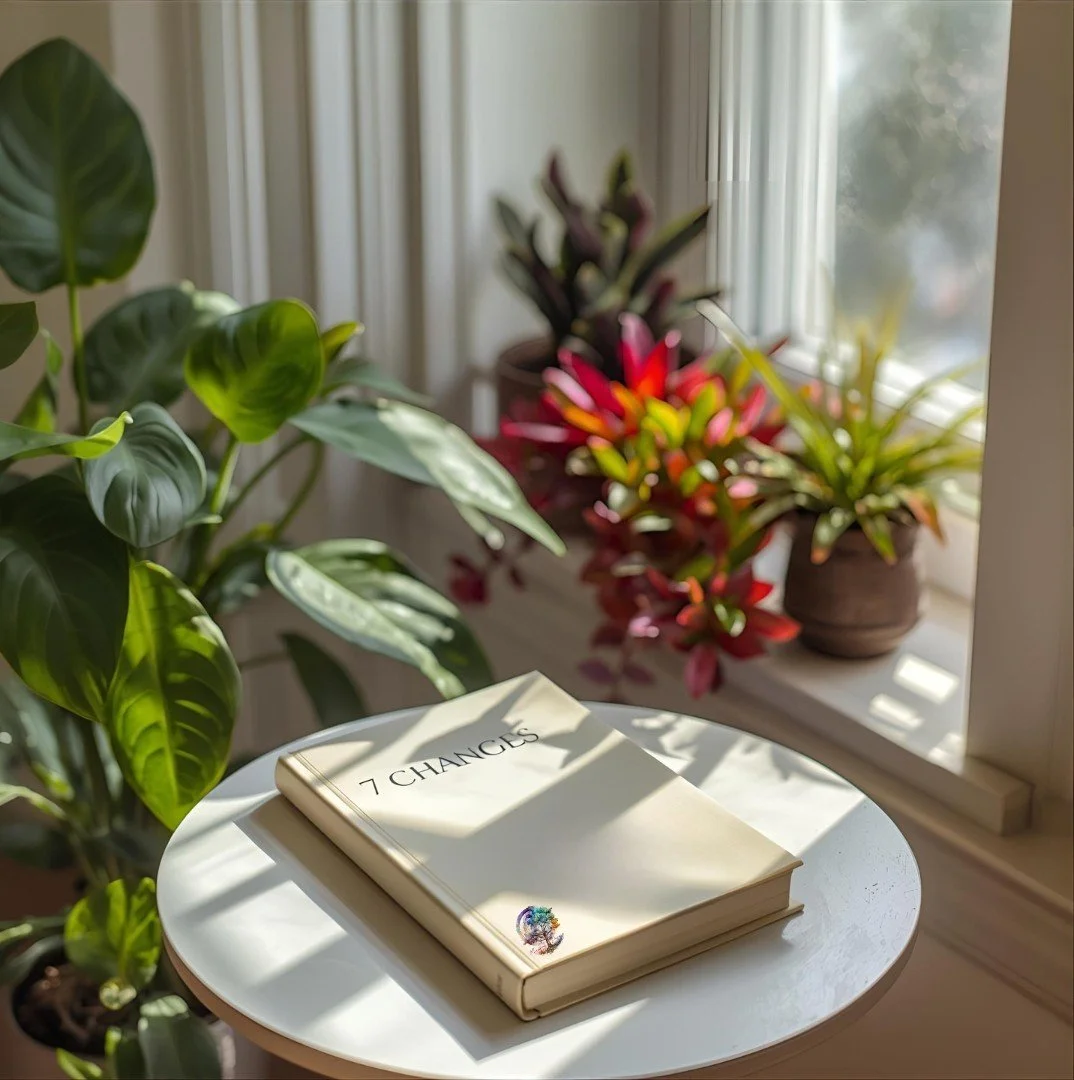
Feng Shui Design
Principles, Practice, & Practical Remedies
Feng Shui is an ancient practice that studies how physical space, orientation, and natural elements influence how we feel and move. At Mindful Design we blend classical tools (form, bagua, compass) with practical interior design to create homes that support wellbeing — not superstition. Read on for approachable methods, quick remedies, and how a consult can make your home feel calmer and more functional.
What is Feng Shui?
Feng Shui (literally “wind” + “water”) is an ancient practice for arranging buildings, interiors, and landscapes so they support healthy energy flow, clarity, and stability. It combines observation, mapping, and material/placement remedies to help homes feel and function better.
Origins & Philosophy
Rooted in millennia of Chinese spatial thinking, Feng Shui blends practical observation of site, climate, and orientation with symbolic systems (like the Bagua and the Five Elements). It is design-led — not dogmatic — and adapts to modern architecture and lifestyle needs.
Historically, Feng Shui emerged from people observing how landscape, water, and shelter influenced wellbeing and fortune. Over time practitioners developed frameworks — the Bagua map to read interiors, the Five Elements to diagnose imbalance, and school-based methods (Form, Compass, and Flying Star) for different types of analysis. Good modern Feng Shui prioritizes safety, clarity, and function. We use these tools to create evidence-based, pragmatic remedies that suit each client’s life and home.
The Five Elements
The Five Elements (Wood, Fire, Earth, Metal, Water) describe types of energy and how they interact. We use them to balance a room for purpose and mood.
Honoring origins — classic symbols reimagined.
This section uses traditional motifs and hand-inked illustrations to illustrate the Five Elements. These visuals are inspired by classical East Asian ink and scroll art and are used here to teach principles — not to appropriate or misrepresent cultural practices.
Wood — Growth & Vitality
Living plants and vertical lines that lift energy and support family and health.
Wood embodies growth and renewal. Add a strong specimen plant, vertical artwork, or warm wood finishes to encourage life and upward movement in spaces that need energy.
Fire — Warmth & Visibility
Warm lighting and bold focal accents that bring presence to a room.
Fire creates momentum and visibility—perfect for entryways and living rooms. Introduce layered lighting, a single art focal point, or a warm accent to lift reputation and social energy.
Earth — Grounding & Stability
Natural textures and ceramics that anchor rooms and support relationships.
Earth tones and tactile materials bring calm and nourishment. Use pottery, woven rugs and low, sturdy furniture to create a stable, supportive center for family and shared spaces.
Metal — Clarity & Precision
Crisp geometry, metallic accents and clear surfaces that sharpen focus.
Metal supports organization and clarity. Introduce tidy storage, metal lighting or small brass details to support workspaces and areas where decisions are made. Balance metallics with warm textures.
Water — Flow & Reflection
Reflective surfaces, small water features and deep-blue accents that renew flow.
Water encourages flexibility and perspective. Use mirrors, carefully placed water bowls, or blue accents to refresh career and life-path areas—avoid oversized noisy fountains indoors.
Schools & Methods
There are several Feng Shui schools (Form, Compass, Eight Mansions, Flying Star) that emphasize different tools and time-based methods. Nikki’s practice favors pragmatic, evidence-guided approaches: Form (landscape & approach), Bagua mapping for interiors, and practical adaptations of classical methods when they add measurable value. We’ll explain which method we use up front and how we adapt them practically for modern homes.
-
Myth: Feng Shui is superstition
Reality: Many Feng Shui principles overlap with good design — light, circulation, view, and entry clarity — which produce practical benefits.
Myth: You must follow one school rigidly
Reality: Skilled practitioners blend methods depending on site and client.
-
Consider a consultant for remodels, new construction, or when multiple household members disagree about placement. A short mini-audit (30–60 minutes) often reveals a handful of high-impact, low-cost improvements.
-
Form School is the oldest, most intuitive branch of Feng Shui. Practitioners observe the shape and features of the surrounding landscape — hills, water, roads, trees, and the approach to a building — because these physical forms influence how energy (qi) moves. In practice we look at the home’s entry, the direction and slope of surrounding land, and large architectural features to identify opportunities and constraints.
Why Nikki uses it: Form readings are highly actionable and non-dogmatic — they often point to simple fixes (planting, screening, entry improvements) that improve flow without complicated rules.
-
Compass School layers orientation onto Form analysis. A compass (or Luo Pan) is used to determine precise directions for the home and rooms, then correlated to different life areas and energies. This method can be helpful when a client wants a deeper, directional prescription (for example, which wall to place a focal piece on), but it is more technical and often requires exact measurements.
Why Nikki uses it selectively: Compass techniques are useful in some contexts—especially new construction or when clients want a time- and direction-based approach—yet we balance these recommendations with the real constraints of site and lifestyle.
-
Eight Mansions assigns “favorable” and “unfavorable” directions based on a person’s birth data and the house orientation. It’s commonly used to decide bed or desk placement and quick remedial placements. It’s straightforward and client-friendly for basic guidance, but it’s less useful for complex sites or multi-person households because directional “goodness” can conflict for different occupants.
Why Nikki uses it sparingly: Great for quick practical tips (where to place a desk or bed) but we avoid rigidly enforcing it when it would harm function or comfort.
-
Flying Star Feng Shui maps how energies change over time using numeric “stars.” It can be used to optimize renovations or to time interventions (e.g., where to place enhancements for a particular multi-year cycle). Flying Star is powerful for long-range projects because it accounts for both location and time, but it’s more technical and best used by trained practitioners.
Why Nikki uses it when appropriate: We apply it for larger remodels or when clients want an advanced reading; otherwise we prefer simpler remedies that are easier to implement and maintain.
-
Black Hat Sect (often called BTB) is a modern hybrid system that emphasizes practical, intuitive tools (like the bagua) and is widely used in western practice. It’s approachable and visually easy to teach clients. Because it’s a more contemporary method, it’s sometimes criticized by classical purists — but it can be an excellent starting point for homeowners who want clear, simple guidance.
Why Nikki uses it pragmatically: BTB methods are highly teachable and translate well into client-friendly deliverables (moodboards, placement advice, small fixes). We combine them with Form and Compass methods when needed.
-
Nikki’s practice emphasizes evidence-guided Feng Shui: we use the best tools from the classical schools (Form, Bagua, Compass/Flying Star when useful) but always prioritize safety, building code, structural realities, and the client’s daily needs. The goal is not ritual but better living—clear circulation, light, functional layout, and a few targeted remedies that are beautiful and effective.
6 Quick remedies you can try this week
Clear circulation & declutter :
Why it works: Physical clutter blocks movement and attention; clearing pathways immediately improves how a space feels.
Do: Remove items from entryways; clear one counter; box up unused things.
Layered lighting (ambient + task + accent):
Why it works: Proper lighting balances energy — ambient for safety, task for focus, accents for warmth.
Do: Add a lamp in dim corners; warm bulbs on dimmers; small accent lamp by entry.
Add a living specimen (plant):
Why it works: Plants introduce oxygen and living energy; one healthy specimen transforms a room.
Do: Choose a low-maintenance specimen and place where it gets light; rotate monthly.
Mirror placement for light & perspective:
Why it works: Mirrors increase perceived space and reflect natural light into darker corners, improving circulation of visual energy — but placement matters.
Do: Reflect a pleasant view or light source; avoid reflecting beds or front doors.
Stay in the flow — sign up for our invite-only Q&A, secret Feng Shui remedies, and design tips →
Refresh the front door arrival experience:
Why it works: The front door is the primary mouth of qi; cleaning, lighting, and a clear sightline invite positive energy.
Do: Sweep/polish threshold; add porch light; remove obstacles; add a single welcoming accent.
Anchor with texture & color (small edits):
Why it works: Texture and a considered color accent add life and emotional warmth without a full redesign.
Do: Add a textured throw, jewel-tone pillow, or a ceramic object.
How Nikki works
Discover — Kickoff: goals, orientation, and a short site read.
Design Development — Concept & prioritized remedies, small fixes to medium solutions.
Install & Reveal — Procurement & coordinated implementation or clear DIY steps you can follow.
If you’d like a consult,
FAQs
-
No. It’s an environmental design practice based on observation.
-
Sometimes; method depends on the client’s goals and the house.
-
Many remedies are DIY-friendly; complex remodels benefit from a consultant.
-
Small shifts often feel different within days; full impact varies.
-
Safety is always paramount; we will never suggest anything that compromises structure, code, or wellbeing.








